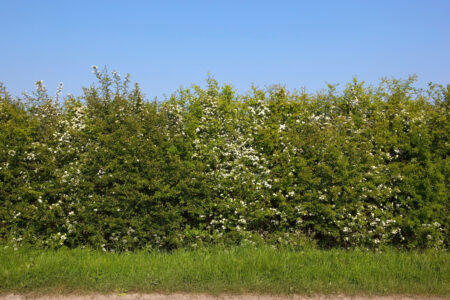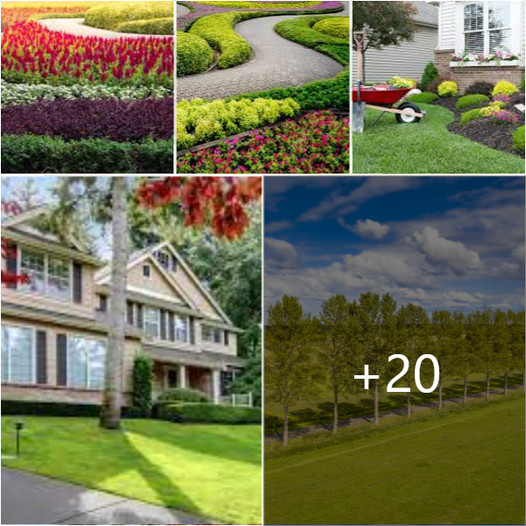Knowing your home’s solar orientation will help you design a landscape that does not contribute to solar heat gain during the hottest time of the year while making maximum use of solar energy when it’s desirable in the wintertime. Depending on where you live, the latitude of the sun will be at different degrees throughout the day and the seasons. Understanding which parts of your home are exposed to sun or shade at different times of the day and year will help you determine the location of trees, shrubs, and other plants for the greatest comfort and economic benefits.
Location, Location, Location
It is not usually recommended to plant trees — especially dense evergreens — on the south side of the house, as they block too much sun in the winter time; at least for those living in colder climates in the Northern Hemisphere. In warmer climates, this rule may be tossed out. Substitute deciduous climbing vines on an arbor, pergola, or trellis. Alternatively, plant deciduous trees or a dense hedge on the east and west sides of the house that will see a lot of sunlight during the early morning and late afternoon. Tall, perennial grasses may be another option. If you wish to plant evergreens, situate them on the northwest or northeast sides of your home.
Keep in mind the height of your plant selections when they will be at full maturity — be sure not to position trees too close to the house. Similarly, consider the length of the shadows they will cast at any given time during the year, as this will affect where you situate them.
During summer, cooling the air outside around your house in addition to creating shade will help keep the indoor temperature at a comfortable level. Not only do judiciously placed trees and shrubs harness prevailing winds and push them toward the house, but as they grow, plants help cool the air through a process called transpiration. Transpiration occurs when water is transferred from roots to leaves, and the stomata (pores) on the surface of a plant’s leaves open to release the water, evaporating into the surrounding air and creating a cooling effect in the immediate area of the plant. The larger the leaf surface on a plant, the greater the cooling capability it has, which means that big trees are valuable cooling engines.

The cooling effects of transpiration are less noticeable in arid regions, where the moisture content in the soil is low. To help your plants and trees out, use plenty of mulch around the base. It is a good idea to keep the ground temperature as cool as possible during the summer in most areas. You can do this by planting perennial groundcovers, such as ferns, mosses, herbs, flowers, and low shrubs; decreasing the amount of turf in your yard; and locating paved surfaces away from your home.
In hot, humid climates, it may be more useful to create a guide to channel prevailing winds toward your home during the summer. Try planting rows of trees or dense hedges parallel to the direction of the wind. In most parts of the continental United States, prevailing winds generally move from west to east.
If you still require an air conditioning unit to keep the house cool, remember to position it away from south and west windows and shade it by planting a tree nearby. The energy-gobbling appliance will function up to 10 percent more efficiently if it is out of the sun. But also do not plant the tree too close and restrict the air flow around the unit.
Green Roof
Another option for cooling in warm climates and reducing heat loss in colder regions is the use of a “green roof.” Green roofs are comprised of layers of a waterproofing material, growing medium, and plants such as sedums and grasses. There are intensive and semi-intensive systems that can support more media and a wider range of plants. In addition to their energy conserving benefits, green roofs may provide storm water collection and noise insulation, as well as serve as habitat for birds, insects, and other wildlife.
Windbreaks
If bitterly cold winter winds are putting a chill on your winter heating costs, try planting a windbreak, also called a shelterbelt. Windbreaks will not prevent the wind from reaching your home, but will greatly slow wind velocity. They should be at least 10 to 20 feet longer than the length of the building they are sheltering.
While most people are familiar with windbreaks of large evergreens and conifers, mixed plantings can also be effective at blocking the wind. Plant large conifers, deciduous trees, and shrubs together in rows, with the shortest plants closest to the house. Combine plants with various growth rates for maximum effectiveness. Quick-growing species may not live long, but will provide more immediate relief from the wind while the slower growing and longer lasting trees fill in. Mixed plantings also provide habitat for wildlife and reduce the risk of pests or diseases wiping out an entire stand of the same plant species. You may wish to avoid planting fruit trees as windbreaks, as the fruit could suffer damage due to exposure.

It is actually better to have a slightly porous windbreak, where some of the wind can get through, than a solid “wall.” This actually reduces the velocity of the wind and disperses it over a larger area. Another benefit of a permeable windbreak is that it catches accumulated snowfall and distributes it more evenly over the ground.
When planting a windbreak, be sure to consider the mature height and spread of all the trees you plant, and give them sufficient room right from the beginning. You must strike a balance: A windbreak is only effective if the plants are spaced tightly, but if planted too close together, they may not grow properly to be effective at blocking wind.
Plant the windbreak away from your house at a distance between two and five times the mature height of the tallest trees you plant, as this will provide the greatest energy savings for your home. For example, if you plant a tree whose mature height is 20 feet tall, locate it at least 40 feet away from your house. Never plant a windbreak too close to the house. As the trees mature, they may end up creating too much shade or even doing damage with their encroaching root systems or blowdown during storms and strong winds.
Bear in mind that some plant selections commonly used for windbreaks may spread vigorously, which is either a desirable trait if you wish to fill a large space quickly, or an unwelcome growth habit. Do your research before ordering plants to ensure you don’t have a mess on your hands later.
If you don’t have space for a large tree windbreak, plant living buffers instead. Place trellises with vines on the sides of the house exposed to the prevailing winds, or group together short, dense shrubs 1 to 3 feet away from the foundation of the house. Try selections such as roundleaf serviceberry (Amelanchier sanguinea), wild hydrangea (Hydrangea arborescens), groundcover junipers, or compact rhododendrons or azaleas.
Consider native plants for energy-saving landscaping. Compared to many non-native species, they are usually low maintenance and require less water, which will also help out on your water bill. Native plants are also attractive to beneficial insects and birds. Planting a diverse range of species is friendly to pollinators and wildlife, and discourages infestations of pests and diseases.
Always plant according to your hardiness zone and choose plants that do not need too much maintenance in winter. When planting, also consider the needs of the plants themselves, and adhere to their preferred soil, light, and water requirements. With careful planning and planting, you’ll see a difference in your home heating and cooling costs in no time.
Suggested plants for cooling the air
Trees 20 to 35 feet tall –
• Red buckeye (Aesculus pavia)
• Eastern redbud (Cercis canadensis)
• Showy mountain ash (Sorbus decora)
• Nannyberry viburnum (Viburnum lentago)
• White fringetree (Chionanthus virginicus)
Shrubs 20 feet tall and under –
• Red chokeberry (Aronia arbutifolia)
• Redosier dogwood (Cornus sericea)
• Common ninebark (Physocarpus opulifolius)
• Roundleaf serviceberry (Amelanchier sanguinea)
• Maple-leaf viburnum (Viburnum acerifolium)
Suggested plants for windbreakers 35 to 50-plus feet tall
• Common hackberry (Celtis occidentalis)
• White ash (Fraxinus americana)
• Bur oak (Quercus macrocarpa)
• American linden (Tilia americana)
• Ohio buckeye (Aesculus glabra)
• Balsam fir (Abies balsamea)
• White spruce (Picea glauca)
• Douglas fir (Pseudotsuga menziesii)
• Eastern arborvitae (Thuja occidentalis)
• Hawthorn (Crataegus spp.)
